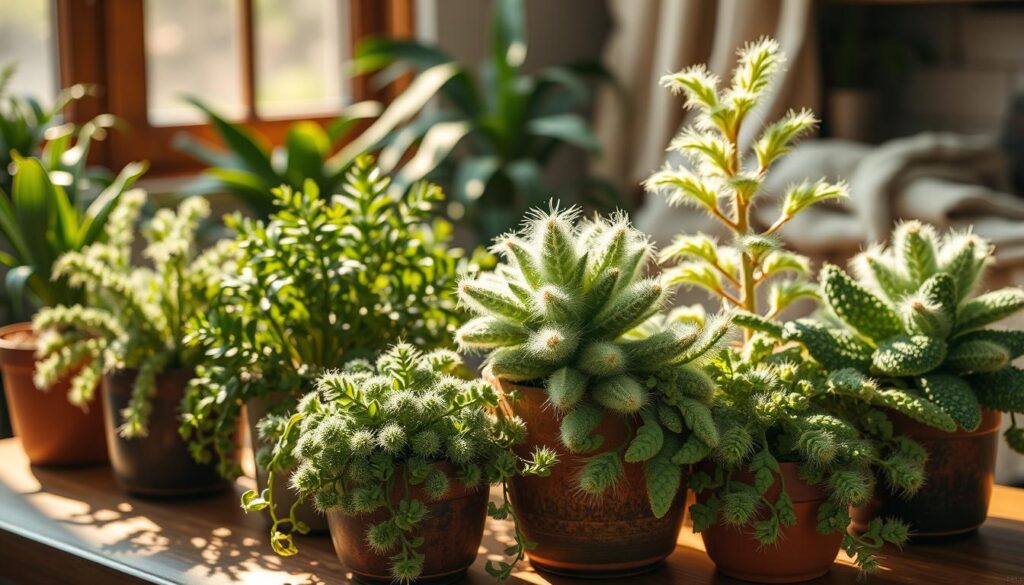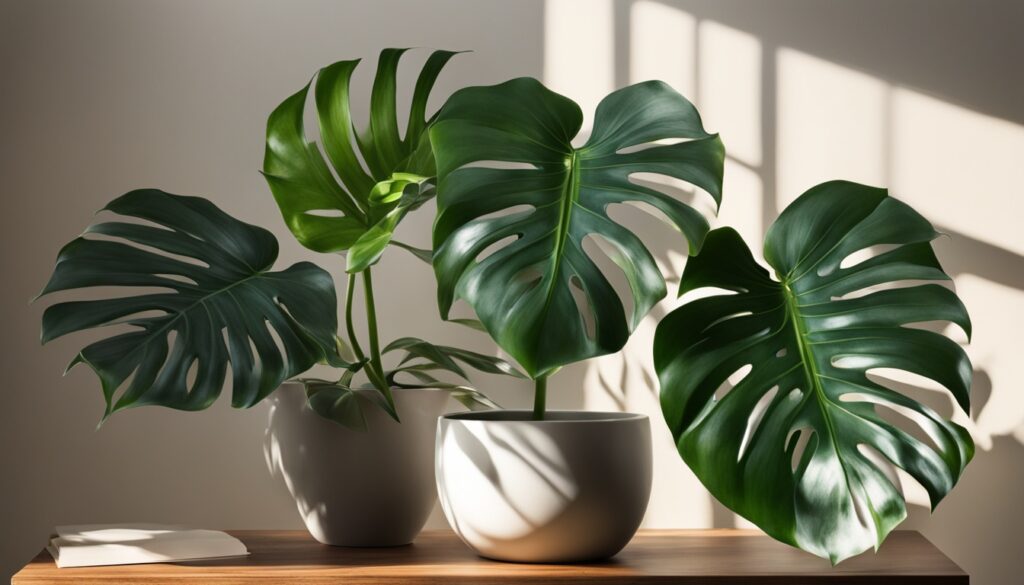Imagine touching a leaf that feels like velvet. It’s soft and full of color. Indoor plants with fuzzy leaves can make your home feel cozy. These houseplants not only look good but also make your space feel warm and inviting.
Ever wondered why some indoor plants feel so good to touch? Find out about plants with soft, fuzzy leaves. They can change how your home looks and feels.
Key Takeaways
- Soft, fuzzy leaves on indoor plants can add a cozy, tactile element to your home decor.
- Explore popular varieties like velvet plants, panda plants, and African violets for their plush, velvety textures.
- Fuzzy-leaved plants can enhance the visual interest and warmth of any living space.
- These plants offer a unique sensory experience and can be low-maintenance options for beginner and experienced plant enthusiasts alike.
- Proper care, including attention to light, water, and humidity, is crucial for keeping these furry houseplants thriving.
Introduction to Soft Fuzzy Houseplants
Fuzzy-leaved houseplants are a great choice for adding warmth and beauty to your home. These indoor plants with soft, fuzzy leaves make any room feel cozier. You can find everything from the cute panda plant to the lively velvet plant.
Why Furry Plants Add Interest and Texture
The soft, velvety textures of these fuzzy foliage plants are irresistible to touch. They not only look great but also feel soothing. Whether they’re on shelves, windowsills, or in a stunning display, fuzzy-leaved houseplants make any indoor living environment feel cozy.
Popular Varieties of Fuzzy Leafed Plants
- Panda Plant
- Velvet Plant
- African Violets
- Iron Cross Begonia
These are just a few of the many furry plants that can add softness and interest to your houseplants. Each one has its own special charm and needs, making them great for any indoor garden.
“Incorporating fuzzy-leaved plants into your home decor is a wonderful way to create a cozy, inviting atmosphere that appeals to the senses.”
Panda Plant: A Fuzzy Succulent for Beginners
The panda plant, also known as the bear paw succulent, is great for new plant owners. It adds texture and interest to your indoor garden. As a fuzzy succulent, it’s easy to care for and needs little water, making it perfect for beginners.
Its soft, fuzzy leaves and unique spotted patterns make it stand out. Kalanchoe tomentosa, the scientific name, comes from central Madagascar’s mountains. This succulent can survive on stored water, making it great for dry periods.
Indoors, the panda plant grows 1-2 feet tall. It fits well on tabletops, windowsills, and shelves.
The panda plant’s fuzzy blue-green leaves have trichomes for insulation and moisture. Its leaves have reddish-brown dots and bands, creating a striking look. Varieties like ‘Chocolate Soldier’ and ‘Golden Girl’ have dark brown edges and warm yellow-green leaves.
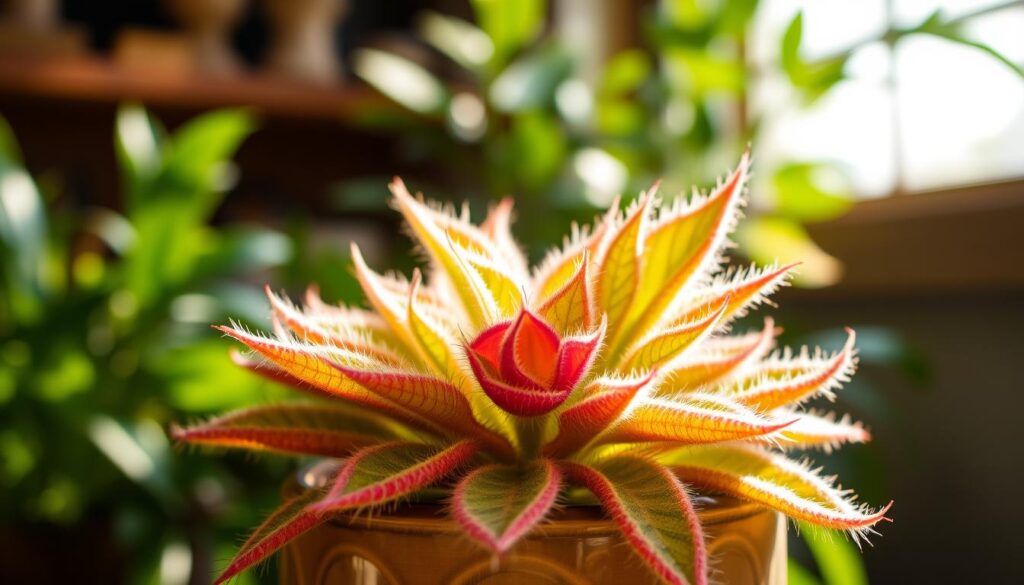
Caring for the panda plant is easy. Water it when the soil is dry, about every 2-3 weeks. Don’t overwater. Fertilize with a diluted cactus and succulent food in spring and summer. Prune only to remove spent or damaged leaves.
The panda plant fights off pests and diseases well. Its hardiness and unique look make it a favorite among beginners and plant lovers.
Velvet Plant: Vibrant Color and Velvety Texture
Looking to add luxury and color to your home? The velvet plant, also known as the purple passion vine, is perfect. It has green leaves with a soft, fuzzy purple coating, making it a standout.
The plant’s vining habit is great for hanging baskets or trellises. This lets you show off its velvety texture and vibrant color. For it to thrive, give it bright, indirect light and water it when the soil is almost dry.
Care Tips for the Velvet Plant
Taking care of the velvet plant is easy, but there are a few things to remember:
- Light: It loves bright, indirect light. Direct sunlight can burn its fuzzy leaves.
- Watering: Water it often, but let the soil dry a bit between waterings. Too much water can cause root rot.
- Humidity: It likes a humid environment. Use a pebble tray or mist the leaves to keep it happy.
- Fertilizer: Feed it a balanced, diluted liquid fertilizer every two to three weeks when it’s growing.
With proper care, your velvet plant will show off its velvety texture and vibrant color. It will bring elegance and interest to your home.
African Violets: Charming Fuzzy Bloomers
African violets are perfect for those who love fuzzy leaves and bright flowers. They come in over 16,000 varieties, offering colors like blue, violet, and pink. These plants fit any indoor space, with shapes and colors to match your style.
To care for them, avoid wetting their leaves and use self-watering planters. They love bright, indirect light and a humid environment. Fertilizing them regularly helps them grow and bloom well.
African violets add charm and color to any room. Whether you prefer classic or modern varieties, they’re a great choice. Their fuzzy leaves and vibrant flowers make them a standout in any indoor garden.
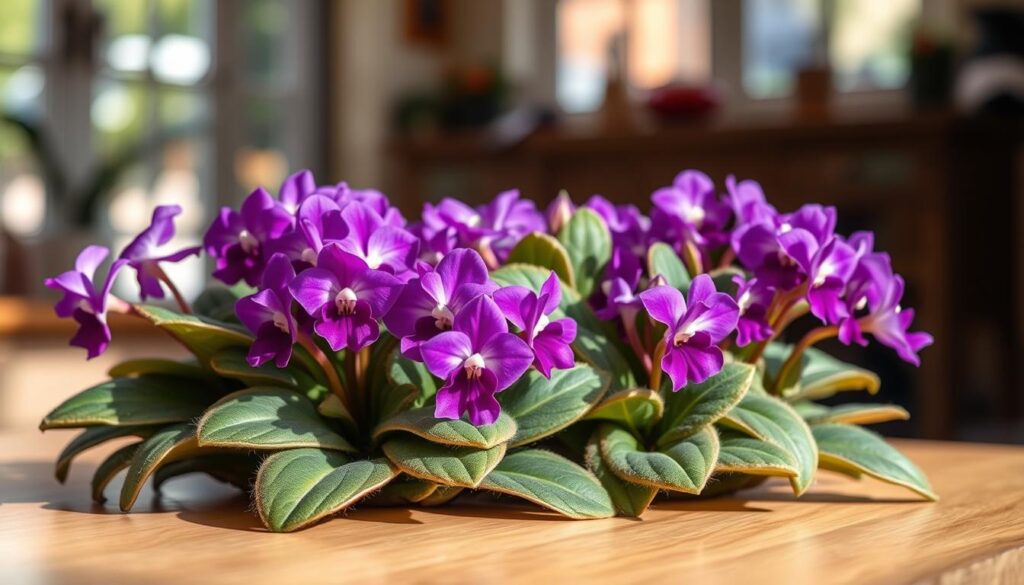
| African Violet Varieties | Bloom Colors |
|---|---|
| Dean’s Aquarius, Humako No Name, IAN Minuet, SK Apple Orchard, Zivay (Morev) | Blue, violet, lavender, pink, red, white |
Watch out for pests like thrips and fungus gnats. Neem oil products can help keep these pests away.
African violets are a favorite for their fuzzy leaves and bright flowers. With the right care, they’ll bring joy to your home for many years.
Iron Cross Begonia: Bold Patterns and Texture
The iron cross begonia is unique, with leaves that show off bold patterns and textures. Its leaves have a dark central mark that looks like a Crusader’s cross. This is surrounded by small hairs, making it a joy to touch.
These iron cross begonias are great for indoor spaces. They love bright, indirect light and need regular water. They’re easy to care for and add beauty to any room.
Looking to add the iron cross begonia to your home? Make sure it gets the right light and water. With the right care, it will bring stunning foliage to your indoor plants.
| Begonia Variety | Leaf Pattern | Flower Color | Light Needs |
|---|---|---|---|
| Iron Cross Begonia | Distinctive dark central marking resembling a cross | N/A (grown for foliage) | Bright, indirect light |
| Olympia Red Wax Begonia | Dark bronze leaves | Small red flowers | Partial to full sun |
| Cocktail Wax Begonia | Dark reddish leaves | Soft white and pink flowers | Partial to full sun |
| Bada Boom Pink Begonia | Green leaves | Bright pink blossoms | Partial to full sun |
Begonias are a diverse and fascinating genus. They offer a wide range of begonia varieties to explore. From the striking iron cross begonia to the vibrant wax begonias, these textural plants with patterned leaves can elevate the visual interest in any indoor space.
Piggyback Plant: A Unique Fuzzy Native
The piggyback plant is a standout among houseplants. It’s native to the western United States and is also known as the Mother of Thousands or Thousand Mothers. Its unique growth habit makes it different from most tropical plants found in homes.
The name “piggyback plant” comes from how new leaves grow from the base of older ones. This creates a fun “piggyback” effect.
Humidity Requirements for Piggyback Plants
Piggyback plants need a lot of humidity, at least 50%. To keep your plant happy, use a humidifier or put it in a steamy bathroom. This will meet its humidity needs. With the right conditions, these unique houseplants can thrive and be the highlight of your native plants garden.
These plants keep producing leaves, with older leaves growing “daughter” plantlets. These offshoots appear mainly in spring and summer. In spring, they also bloom with tiny, elegant flowers on 6-10 inch spikes.
Even though they’re native plants from the Pacific Northwest, only a few types are available for sale. Still, these humidity loving plants are a favorite for hanging baskets. They do well in the right conditions and are loved for their unique growth and soft, fuzzy leaves.
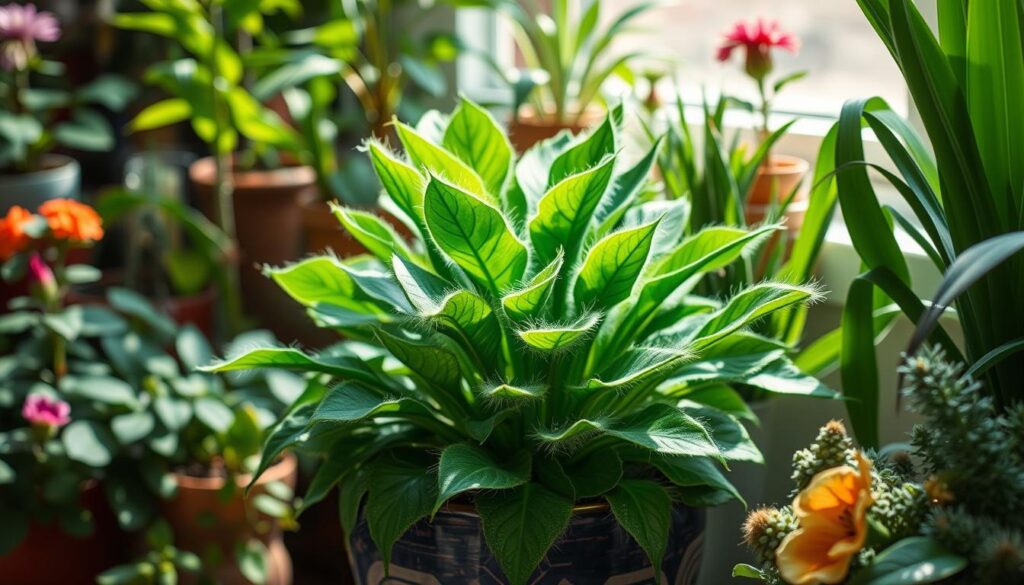
“Piggyback plants are plentiful along several family-friendly trails in the Columbia River Gorge, offering a delightful encounter with this unique houseplant in its natural habitat.”
Lamb’s Ear: An Outdoor Fuzzy Brought Indoors
Lamb’s ear (Stachys byzantina) is a perennial herb known for its soft, velvety leaves. It’s often grown outdoors but can also do well indoors. As an indoor houseplant, it brings a unique touch and keeps its growth in check.
This plant is great for indoor spaces, needing lots of bright light. It grows 12-18 inches tall and 12-36 inches wide. Its leaves are a beautiful silvery-gray or blue-green, feeling soft to the touch.
Indoors, lamb’s ear likes well-drained, slightly acidic soil and about 1 inch of water weekly. It’s quite drought-tolerant but might shed leaves in dry times. Varieties like ‘Big Ears,’ ‘Silver Carpet,’ and ‘Cotton Boll’ have larger leaves or woolly stalks.
Lamb’s ear is a great, easy-to-care-for indoor houseplant. It adds a soft, fuzzy feel to any room. Its deer-resistant nature makes it a favorite among gardeners.
“Lamb’s ear is a wonderful, low-maintenance plant that can thrive in a variety of environments, from outdoor gardens to indoor living spaces.”
Pussy Ears: A Purple Succulent with Soft Bristles
Meet the pussy ears, a succulent with a unique look. Its leaves are fuzzy and lance-shaped, covered in soft white bristles. The leaves can be bright green or deep purple, depending on the light it gets.
This succulent can grow up to 12 inches tall. It has a cascading habit, perfect for hanging baskets or displays. It’s not as common, but it’s definitely worth finding for a unique indoor garden.
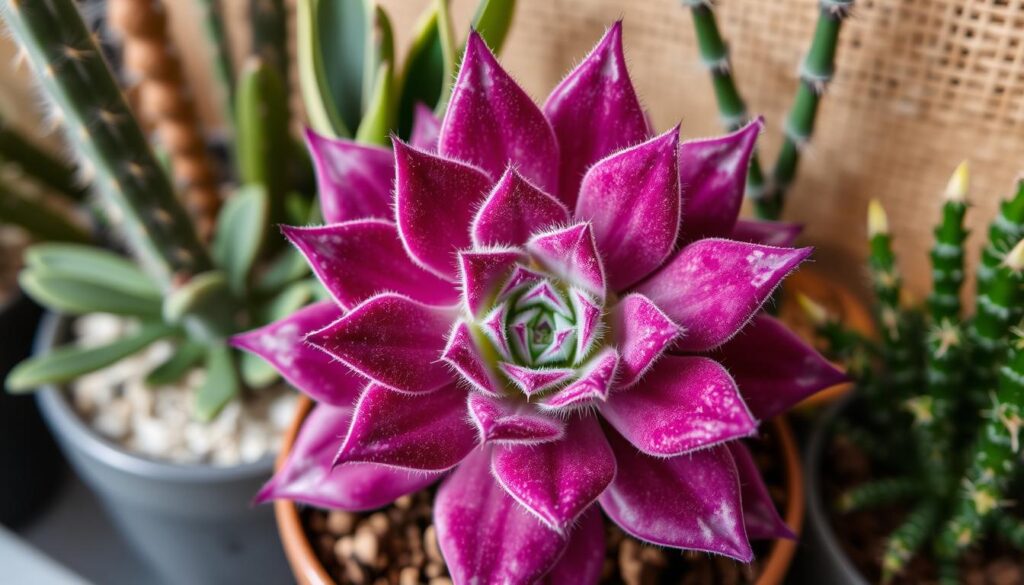
“The soft, bristled leaves of the pussy ears succulent create a captivating textural contrast in any indoor space.”
The pussy ears succulent is great for those who want something special. It’s easy to care for and stands out in any room. Whether alone or with other plants, it’s sure to grab attention.
Chenille Plant: A Cascading Floral Spectacle
The chenille plant can grow well indoors, adding color all year. It has heart-shaped leaves and fluffy crimson flowers that look like chenille fabric. While it needs more care, it’s worth it for its beautiful blooms.
The Chenille Plant is known for blooming all year, adding color to any space. Its tactile blooms make it a great conversation starter. NASA says it helps clean the air by removing toxins.
This plant is good for your mood, helping to reduce stress and boost productivity. It’s a thoughtful gift, symbolizing care and love. Chenille Plants are easy to care for, needing only full sun.
It attracts pollinators, helping nature and the environment. The Chenille Plant has been valued for its beauty and possible health benefits for a long time.
“The Chenille Plant’s cascading floral spectacle is a true delight, brightening any indoor space with its vibrant hues and soft, fuzzy texture.”
Old Man Cactus: Fuzzy Spines for Texture
When you think of cacti, you might not think of soft, fuzzy plants. But the old man cactus is different. It has spines covered in delicate, white hairs. This gives it a unique, textural look.
Unlike most fuzzy cactus and textural cacti, the old man cactus loves bright light and doesn’t need much water. This makes it perfect for indoor gardeners who want something special.
The old man cactus, also known as Espostoa Lanata, comes from Northern Peru and Southern Ecuador. It grows slowly and can get up to 25 feet tall outside. But indoors, it usually stays around 3-4 feet tall.
Its stems are 3 to 10 inches wide. They are covered in the fuzzy spines that make it look like an old man cactus.
The old man cactus might not bloom for 10 or 20 years. But its textural cacti leaves make it a beautiful indoor plant. Still, it can get sick if it gets too much water. So, it needs the right amount of light and water to do well indoors.
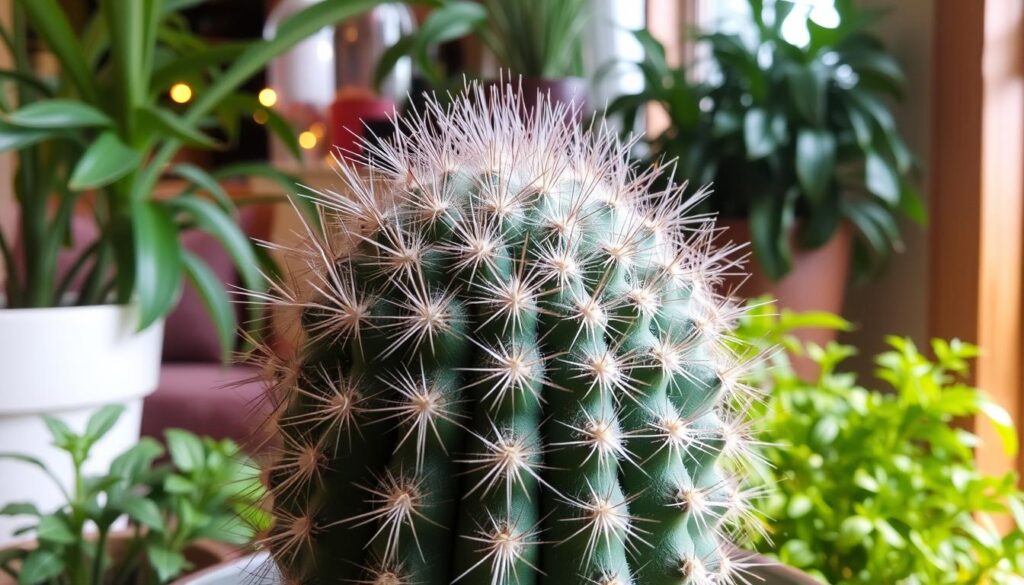
Even with its special needs, the old man cactus is a standout fuzzy cactus. It adds a unique touch of texture and interest to any room. Its textural cacti look and slow growth make it a great choice for those looking to add something special to their unique houseplants collection.
indoor plant with soft fuzzy leaves: Caring Tips
Caring for fuzzy leafed houseplants needs a bit more effort. These plants, from Calathea to velvet plants, have special light, water, and humidity needs. Meeting these needs keeps their leaves looking vibrant.
Light, Water and Humidity Needs
Most fuzzy-leaved plants love bright, indirect light. Direct sunlight can burn their leaves. So, place them where they get plenty of light but avoid direct rays.
Watering is also crucial. Let the soil dry a bit between waterings. Some plants, like the piggyback plant, need at least 50% humidity to do well.
Knowing the right plant care tips for fuzzy leafed houseplants keeps them healthy. With the correct light requirements, watering needs, and humidity, they’ll be a joy for years.
“Caring for indoor plants with soft, fuzzy leaves requires some special considerations.”
Decorating with Fuzzy Leafed Plants
Adding indoor plants with soft, fuzzy leaves to your home can make it warmer and more interesting. These plants fit well with many design styles, from bohemian to modern. You can put them on shelves, coffee tables, or in hanging baskets to show off their texture.
Grouping these plants together can make a lush, textured display. Try different plants and setups to find the right mix of form and function for your home.
There are countless ways to decorate with houseplants. Fuzzy leafed plants like the Panda Plant, Velvet Plant, and African Violets bring a cozy feel. They can be the main attraction or part of a bigger plant display to add texture in home decor.
For a bold plant styling look, group plants like Lamb’s Ear, Chenille Plant, and Old Man Cactus. Their different shapes and textures make a lush, inviting display that’s fun to touch and explore.
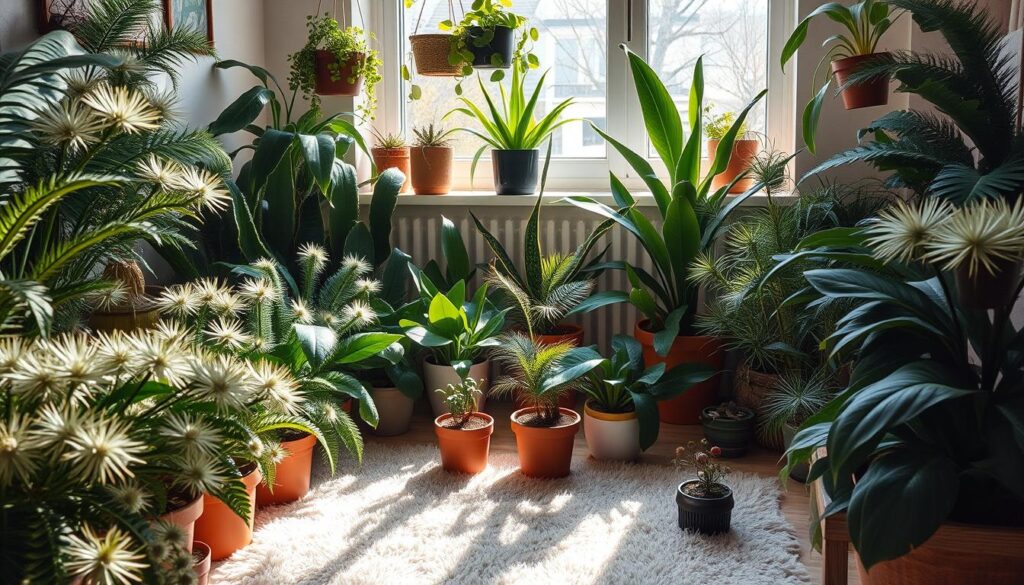
“Incorporating tactile plants into your home decor can elevate the overall experience, appealing to the senses and creating a warm, welcoming atmosphere.”
Fuzzy leafed plants are great for adding coziness to any space, whether it’s modern or bohemian. Try out different setups to find the best way to include these decorative houseplants in your home.
Conclusion
The world of indoor plants with soft, fuzzy leaves is both delightful and unexpected. These plants, like the panda plant and the chenille plant, add warmth and beauty to any space. They bring a touch of nature’s charm to your home or office.
Adding these fuzzy houseplants is a great way to make your space cozier. They come in many colors, shapes, and care needs. This makes them perfect for both beginners and experienced plant lovers.
Starting your journey to a cozy indoor oasis? Let these soft, fuzzy-leaved plants lead the way. They turn your space into a haven of comfort and natural beauty. Enjoy the unique textures they offer and watch your home or office bloom with warmth and texture.
